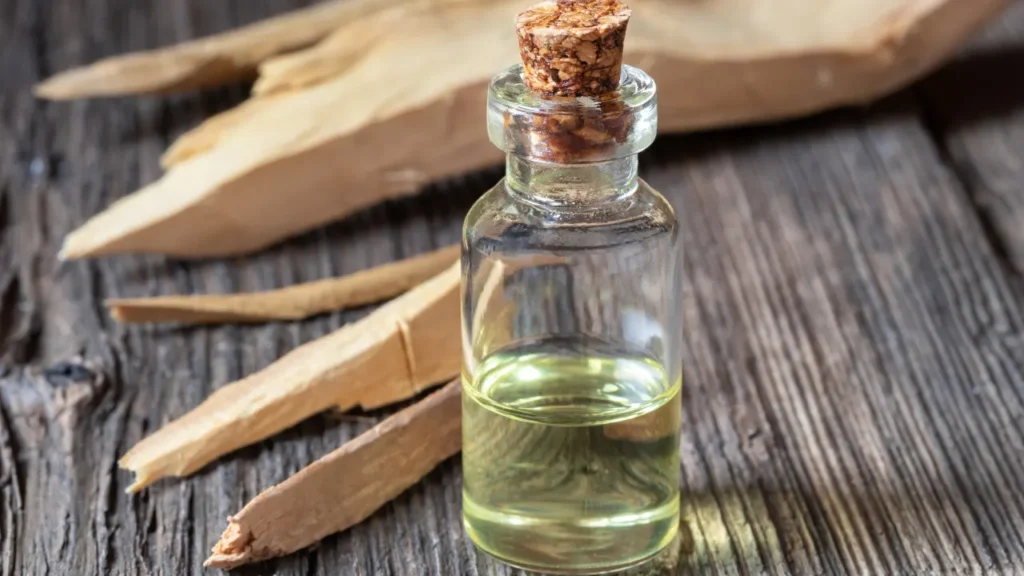White sandalwood is an evergreen tree in the santalaceae family of trees, and is native to India, Indonesia, and Australia. For centuries, it has been used in religious rites, perfumes, and traditional medicine due to its aromatic heartwood and essential oil. This article highlights white sandalwood’s chemical makeup, physiological properties, potential health benefits, ideal dosage, side effects, and potential drug interactions. The goal is to give readers a thorough grasp of how to use this dietary supplement responsibly and profitably.
You May Also Like:
The Best Mushroom Supplements for Memory: 5 Top Brands Reviewed
The Best Supplements for Memory and Brain Fog: 5 Top Brands Reviewed
White Sandalwood: Benefits, Dosage, Side Effects, Drug Interactions, And Other Important Information is an original (NootropicsPlanet) article.
Nature of White Sandalwood
Santalum album (white sandalwood) is a small, slow-growing evergreen tree native to India, Indonesia, and Australia. It is a member of the santalaceae family and is known for its aromatic heartwood, which has been used for ages in traditional medicine, religious rites, perfumery, and in the production of furniture and artwork. The tree can reach a height of 33 feet (10 meters), with slender branches, leathery leaves, and small, inconspicuous blooms. The heartwood, which accumulates in the center of the tree over time, is dense, yellowish-brown, and has a distinct scent. White sandalwood’s therapeutic benefits are mostly derived from the essential oil produced from the heartwood, making it a beneficial element in a variety of health-related applications.
Health Benefits
Although research into the health benefits of white sandalwood is still in its early stages, preliminary findings indicate numerous potential medicinal applications:
1. Antimicrobial Activity: White sandalwood oil has been shown to be antimicrobial against a variety of pathogens, including staphylococcus aureus, escherichia coli, candida albicans, and herpes simplex virus. This supports its historic usage in treating skin infections, respiratory infections, and other pathogenic microorganism-caused diseases.
2. Anti-inflammatory Properties: White sandalwood oil’s anti-inflammatory properties can be effective in treating inflammatory skin disorders such as acne, eczema, and psoriasis. More research is required to confirm these findings and investigate possible uses in additional inflammatory illnesses.
3. Anticancer Potential: Preliminary research indicates that white sandalwood oil and its constituents, including -santalol and -santalol, have anticancer properties. In several in vitro and in vivo settings, these drugs have been shown to cause apoptosis in cancer cells, reduce tumor development, and prevent metastasis. More research is needed to determine the precise processes underlying these effects and to assess white sandalwood’s potential therapeutic implications in cancer treatment.
4. Neuroprotection: Some studies suggests that white sandalwood oil has neuro-protective properties, which could help to alleviate symptoms of anxiety, despair, and cognitive loss. However, the fundamental processes and clinical implications of these discoveries need to be investigated further.

Chemistry of White Sandalwood
White sandalwood’s main bio-active components can be found in its essential oil, which is produced by steam distilling the heartwood. Sesquiterpenes, sesquiterpenols, and other volatile chemicals make up the oil’s intricate chemical makeup. Among the essential elements are:
1.A-Santalol: -Santalol is a sesquiterpene alcohol with antibacterial, anti-inflammatory, and anticancer effects. It makes up between 40% and 60% of sandalwood oil’s makeup and is the primary active ingredient.
2. B-Santalol: This sesquiterpene alcohol, which makes up 20–30% of the oil’s makeup, has qualities similar to -santalol.
3. Epi-β-Santalol: This one is a negligible component of sandalwood oil that may have anti-inflammatory and anticancer effects.
4. -bisabolol, and -bergamotol: These are other substances that are less well-known sesquiterpenes and sesquiterpenols that also include lanceol, and they make up the remaining components of sandalwood oil.
Physiological Properties of White Sandalwood
Although the physiological processes through which white sandalwood exerts its positive effects are not entirely understood, recent research points to a number of plausible pathways:
1. Antibacterial Properties: Sandalwood oil has been shown to have antibacterial properties against a range of bacteria, fungi, and viruses. This explains why it has long been used as a treatment for infections and wound healing.
2. Anti-Inflammatory Properties: Constituents of white sandalwood oil, such as -santalol and epi-santalol, have been shown to modulate inflammatory responses by inhibiting the activation of nuclear factor-kappa B (NF-B), a crucial transcription factor involved in the inflammatory response, and by suppressing the production of pro-inflammatory cytokines.
3. Anticancer Effects: In numerous in vitro and in vivo investigations, the -santalol and -santalol in white sandalwood oil have shown anticancer activity, inducing apoptosis in cancer cells and restraining tumor growth. Further research is necessary to completely understand the precise mechanisms underlying these anticancer benefits.


Optimal Dosage
Due to the scarcity of research done on white sandalwood, no optimal dosage for its usage as a nutritional supplement has been determined. The recommended dosage can differ depending on the targeted treatment goal, the specific formulation, and your individual characteristics such as your age, weight, and overall health state. Before beginning any supplementation, it is critical to contact a healthcare practitioner, who can provide individualized advice based on your individual needs and circumstances.
Side Effects and Precautions
When used correctly, white sandalwood is generally regarded as safe. Some people, however, may have side effects or unpleasant reactions. Skin irritation or allergic reactions are possible side effects, especially when the oil is administered topically. To reduce the risk of irritation, perform a patch test before applying white sandalwood oil to the skin and dilute the oil with a carrier oil. Pregnant or breastfeeding women, as well as people with pre-existing medical disorders, should consult a doctor before taking white sandalwood supplements, as its safety in these groups has not been adequately proven.


Potential Substance Interactions
White sandalwood, like any other dietary supplement, can potentially interact with other drugs or substances. Some potential interactions to be aware of are as follows:
1. Anticoagulant and Anti-platelet Medications: White sandalwood’s anti-inflammatory properties may increase the effects of anticoagulant and antiplatelet medications, raising the risk of bleeding. Before taking White Sandalwood supplements, those taking certain medications should take caution and check with their healthcare professional.
2. Immunosuppressant Medications: White sandalwood’s immunomodulatory properties can interfere with immunosuppressant treatments, thus lowering their effectiveness. Before taking white sandalwood supplements, anyone on immunosuppressant therapy should contact their doctor.
Best Responsible Use of White Sandalwood
To guarantee the most responsible usage of white sandalwood as a dietary supplement, the following requirements must be followed:
1. Consult a Healthcare Provider: It is critical to seek counsel from a certified healthcare professional before beginning any supplements. They can make tailored suggestions based on your specific needs, medical history, and potential conflicts with other medications or supplements.
2. Select a Reliable Source: To verify that the product is safe, pure, and includes the advertised ingredients, choose a high-quality white sandalwood supplement from a well-known manufacturer. To assist you make a decision, look for third-party certifications and reviews.
3. Begin with a Low Dose: Under the supervision of a healthcare practitioner, begin with a low dose of the supplement and gradually raise it as needed. This method reduces the danger of negative effects while also allowing for the evaluation of individual responses to the supplement.
4. Adhere to the Appropriate Dosage: Follow the manufacturer’s or healthcare professional’s suggested dosage, as exceeding it can result in side effects or potential interactions with other substances.
5. Keep an Eye Out for Any Side Effects or Bad Reactions: By doing this, you can track any negative effects that can develop while taking White Sandalwood pills. If any problems emerge, discontinue use and seek the advice of a healthcare expert.
6. Consider Potential Interactions: Keep in mind the possibility of interactions between white sandalwood and other drugs or supplements. Consult a healthcare practitioner to check that the combination is safe and appropriate for your specific situation.
7. Monitor Progress: Track the effects of white sandalwood supplementation on health outcomes and symptoms to determine efficacy and whether dosage or supplementation duration needs to be adjusted.
8. Use Sustainable Sourcing: White sandalwood is a valuable resource, and its cultivation and harvesting should be done in a sustainable manner to avoid over-exploitation and deforestation. When shopping for white sandalwood, search for products that are sustainably sourced and support ethical methods.
White Sandalwood:
Conclusion
White sandalwood is not only beneficial for health and wellness, but has been historically useful in other areas such as religious rites, the creation of perfume, and even building furniture. However, if you are interested in using white sandalwood as a dietary supplement, it is important to keep in mind the side effects just as much as its benefits. Take all of the listed information in this article in mind, and make sure to talk to a doctor before starting a white sandalwood supplement.


References:
- α-Santalol, a derivative of sandalwood oil, induces apoptosis in human prostate cancer cells by causing caspase-3 activation. Retrieved from: https://pubmed.ncbi.nlm.nih.gov/22292488/
- The anti-inflammatory potential of sandalwood oil (Santalum album L.) in vitro and in vivo. Retrieved from: https://onlinelibrary.wiley.com/doi/full/10.1002/ptr.5145
Important Note: The information contained in this article is for general informational purposes only, and should not be construed as health or medical advice, nor is it intended to diagnose, prevent, treat, or cure any disease or health condition. Before embarking on any diet, fitness regimen, or program of nutritional supplementation, it is advisable to consult your healthcare professional in order to determine its safety and probable efficacy in terms of your individual state of health.
Regarding Nutritional Supplements Or Other Non-Prescription Health Products: If any nutritional supplements or other non-prescription health products are mentioned in the foregoing article, any claims or statements made about them have not been evaluated by the U.S. Food and Drug Administration, and such nutritional supplements or other health products are not intended to diagnose, treat, cure, or prevent any disease.
